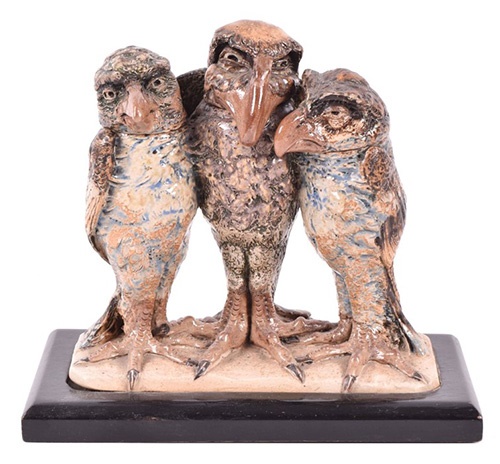What is the Most Expensive Martin Brothers Pottery?
Martinware is valuable and sought-after
31/10/2024
The Martin brothers – Robert Wallace, Walter, Charles, and Edwin – were pioneers in English pottery at the turn of the 20th Century. Their work, known as ‘Martinware’, was described at the time as ‘art pottery’, though now is more similar to what we would call ‘studio pottery’, a term that was coined later. Martinware is known for its rough surface (due to its salt glaze) and its strangeness, with their flamboyant, eccentric designs being very recognisable to collectors. The Martin brothers often crafted sculptures of birds with bizarre and surreal features, as well as bowls, tiles vessels decorate with sea creatures. It is also not uncommon for these strange creatures to have heads that can be removed, to reveal storage space in the body – which was often historically used to store pipe tobacco.
 An early 20th century Martin Brothers triple bird group by Robert Wallace Martin
An early 20th century Martin Brothers triple bird group by Robert Wallace Martin
Nowadays, Martinware is valuable and sought-after; even smaller pieces can fetch very high prices at auction. Collecting Martinware became more popular from the 1970s, and over 100 pieces of Martinware are on display at The Box Museum in Plymouth. Sculptural pieces in particular are very popular with collectors, with some sales reaching in excess of £180,000. However, this popularity sadly came too late for the brothers to see themselves – with Robert Wallace Martin once stating in 1910 that he and his brothers ‘never got more than a labourer’s wages.’ As such, they would only fire their kiln once or twice a year and could not afford to pay for protective containers when firing it – thus the supply of Martinware in good condition is relatively small.
Not all Martinware is worth thousands of pounds however. All of the brothers’ work is skilfully and intricately crafted, but as there is so much variety to what they produced, there are such things as entry level pieces, which will often be valued at around £150. The age, condition and colouring of a piece are all other elements to consider when valuing a piece of Martinware, but the most important factor when thinking about value is character. However, it is important not to be fooled by a piece that seems too good to be true – whether buying or selling.
A Martin Brothers large double-sided stoneware face jug
Unfortunately, as is the case with many other valuable art forms, the market for Martinware is rife with copycats and lookalike pieces. Always be sure to do your due diligence on an item before buying it, and if you are selling, make sure you know for sure what you have your hands on. The team of expert Valuers at Dawsons would be happy to help and will provide a complimentary valuation – giving you an accurate current market value, whilst if you are looking to sell, our in-house marketing team will directly target a huge global audience of known buyers, all with the aim of securing the best price for you.
Generally, the Martin brothers’ earlier work (between 1880-1900) tends to be much more flamboyant, and for that reason, more valuable. After the turn of the century, the influence of Japonism and Art Nouveau meant that their designs were simplified. Following this, production tailed off, with the brothers’ Southall shop closing down upon the outbreak of the Great War in 1914, and the final brother died in 1923.
A Martin Brothers spoonwarmer modelled as a grotesque fish
Whilst the Martin brothers were key figures in the pottery industry in England, the audience for Martinware is truly global. The United States in particular has been home to very high auction prices, and increasing demand among collectors. Therefore, utilising a truly global auction business like Dawsons is an excellent choice to sell any pieces of Martinware that you may have in your collection.
read more
The History of Martin Brothers Pottery
How to Identify Antique Pottery
What Does the Term Studio Pottery Mean?
Are you considering selling any Martin Brothers pottery?
With access to a global audience of over 10 million known buyers, Dawsons can secure the highest price.
Get in touch with an expert Valuer for confidential sales advice, we would be delighted to help:

